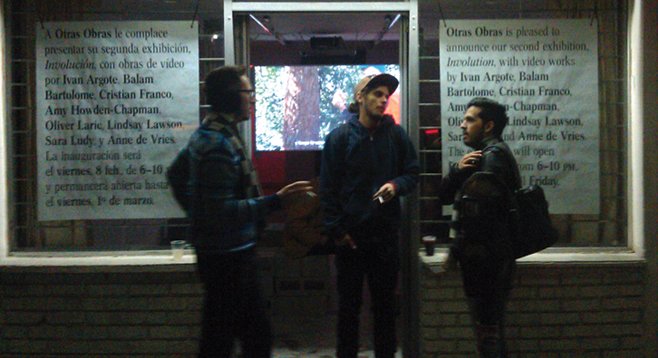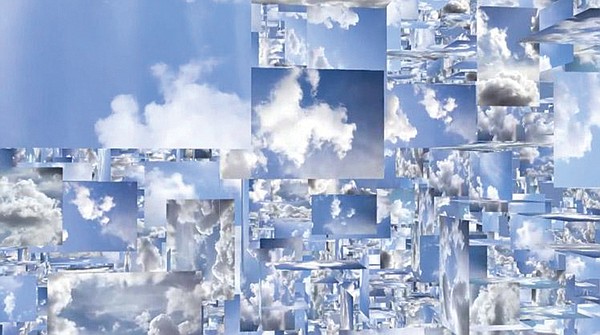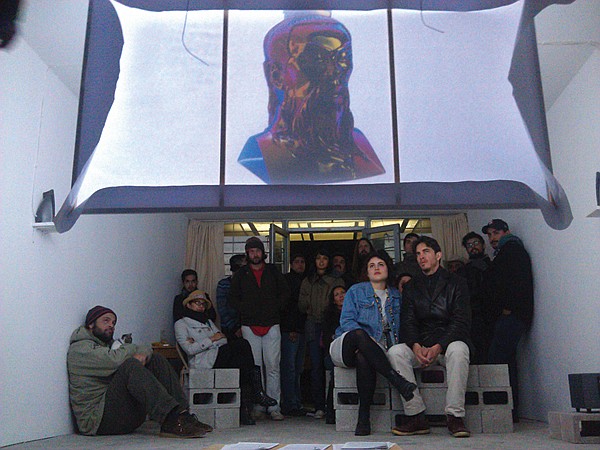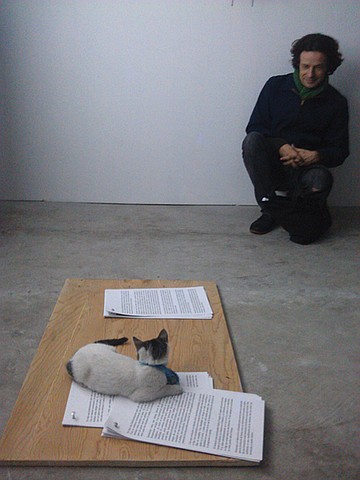 Facebook
Facebook
 X
X
 Instagram
Instagram
 TikTok
TikTok
 Youtube
Youtube

Indian mystic Meher Baba defined involution as “the inner path of the human soul to the Self,” in which the ecstatic rapture of realization is the highest and ultimate purpose of the illusory material world.
Tijuana art space Otras Obras may or may not have had this meaning in mind for their February video exhibition of the same name, but the connotation is indicative of the gallery’s aims.

A joint endeavor of Los Angeles/Tijuana artist Michael Ray-Von and New York festival promoter Todd Patrick, Otras Obras curates installations that deviate from the dominant storylines of contemporary art in Tijuana and, in doing so, provide a forum for shocks of insight and epiphany.
Says Meher Baba, “Before he can know Who he is, man has to un-learn the mass of illusory knowledge he has burdened himself with on the journey from unconsciousness to consciousness.”
Correspondingly, Involution’s curator statement comes off as a fusion of esoteric texts and a wine-fueled Hakim Bey manifesto:
“Involution as a radical rethinking of historical narratives and social formations. A social architecture is an assemblage of images, the form of which constitutes a temporary continuum of identity...innumerable heads inhabiting a single body; a coexistence of influences. By exploiting or exploding the tendencies, or tropes, of a given formation, alternate formations occur. The result is a lingering self-recognition, a turning out upon itself, an involution.... The dancer is practicing in front of the mirror. The mirror is practicing in front of the dancer. The camera is the dancer, and the television is the mirror. And the video-feedback itself is neither the camera nor the television, it’s something that’s between the two terms. And it’s always-already occurring everywhere all the time.... Involution is an auto-betrayal.”

You could even say that Tijuana itself is going through a process of involution. The streets of Zona Centro certainly suggest so.
Calle Sexta, located half a block north of Otras Obras, is the aorta of revived nightlife in the mercurial border city. In the absence of Navy jerks and college-kids-gone-wild humping binge visions of spring break everlasting, the brief downtown stretch is now a bustling node of bars and restaurants catering to local predilections.

Zona Centro is also home to a handful of independent art spaces that — following Baba’s metaphysical path of involution — serve as signposts along the way to Tijuana’s realization of itself.
“One of the elements which turn border cities into unique animals is the stream of disjunct influences,” says Involution co-curator Temra Pavlovic. “The way in which two influences collide and function together is addressed and questioned in the body of Involution.”
While the gallery’s premiere exhibition, To Preserve Disorder, provoked revolutionary sentiments via prison-escapee portraits and a sack of politically charged texts blasted clear across the room by a half-stick of dynamite, Involution dealt a subtler hand.
Video works by Ivan Argote, Balam Bartolome, Cristian Franco, Amy Howden-Chapman, Oliver Laric, Lindsay Lawson, Sara Ludy, and Anne de Vries featured re-appropriated footage from the late ’40s black-and-white film Nosotros los Pobres, images from online archives, and a playful spin on the potter’s wheel scene in Ghost.
Likewise, the city reinvents itself with borrowed imagery from both sides of the border. Is Tijuana more of a sister city to San Diego or a distant satellite of Distrito Federal? Involution doesn’t purport to have the answer.
Says Pavlovic, “We think about the process of involution as a type of movement that presents potential of growth beyond predetermined structures and realities.”
Indeed, Tijuana appears to be doing just that.
Visit otrasobras.mx for details on current and future exhibitions. ■
Crash your party? Call 619-235-3000 x421 and leave an invitation. (@chaddeal)


Indian mystic Meher Baba defined involution as “the inner path of the human soul to the Self,” in which the ecstatic rapture of realization is the highest and ultimate purpose of the illusory material world.
Tijuana art space Otras Obras may or may not have had this meaning in mind for their February video exhibition of the same name, but the connotation is indicative of the gallery’s aims.

A joint endeavor of Los Angeles/Tijuana artist Michael Ray-Von and New York festival promoter Todd Patrick, Otras Obras curates installations that deviate from the dominant storylines of contemporary art in Tijuana and, in doing so, provide a forum for shocks of insight and epiphany.
Says Meher Baba, “Before he can know Who he is, man has to un-learn the mass of illusory knowledge he has burdened himself with on the journey from unconsciousness to consciousness.”
Correspondingly, Involution’s curator statement comes off as a fusion of esoteric texts and a wine-fueled Hakim Bey manifesto:
“Involution as a radical rethinking of historical narratives and social formations. A social architecture is an assemblage of images, the form of which constitutes a temporary continuum of identity...innumerable heads inhabiting a single body; a coexistence of influences. By exploiting or exploding the tendencies, or tropes, of a given formation, alternate formations occur. The result is a lingering self-recognition, a turning out upon itself, an involution.... The dancer is practicing in front of the mirror. The mirror is practicing in front of the dancer. The camera is the dancer, and the television is the mirror. And the video-feedback itself is neither the camera nor the television, it’s something that’s between the two terms. And it’s always-already occurring everywhere all the time.... Involution is an auto-betrayal.”

You could even say that Tijuana itself is going through a process of involution. The streets of Zona Centro certainly suggest so.
Calle Sexta, located half a block north of Otras Obras, is the aorta of revived nightlife in the mercurial border city. In the absence of Navy jerks and college-kids-gone-wild humping binge visions of spring break everlasting, the brief downtown stretch is now a bustling node of bars and restaurants catering to local predilections.

Zona Centro is also home to a handful of independent art spaces that — following Baba’s metaphysical path of involution — serve as signposts along the way to Tijuana’s realization of itself.
“One of the elements which turn border cities into unique animals is the stream of disjunct influences,” says Involution co-curator Temra Pavlovic. “The way in which two influences collide and function together is addressed and questioned in the body of Involution.”
While the gallery’s premiere exhibition, To Preserve Disorder, provoked revolutionary sentiments via prison-escapee portraits and a sack of politically charged texts blasted clear across the room by a half-stick of dynamite, Involution dealt a subtler hand.
Video works by Ivan Argote, Balam Bartolome, Cristian Franco, Amy Howden-Chapman, Oliver Laric, Lindsay Lawson, Sara Ludy, and Anne de Vries featured re-appropriated footage from the late ’40s black-and-white film Nosotros los Pobres, images from online archives, and a playful spin on the potter’s wheel scene in Ghost.
Likewise, the city reinvents itself with borrowed imagery from both sides of the border. Is Tijuana more of a sister city to San Diego or a distant satellite of Distrito Federal? Involution doesn’t purport to have the answer.
Says Pavlovic, “We think about the process of involution as a type of movement that presents potential of growth beyond predetermined structures and realities.”
Indeed, Tijuana appears to be doing just that.
Visit otrasobras.mx for details on current and future exhibitions. ■
Crash your party? Call 619-235-3000 x421 and leave an invitation. (@chaddeal)
Comments